Henbury carbon farm: more than watching the grass grow
22 June 2012
Seasonal pastoral-type jobs will be on offer to locals
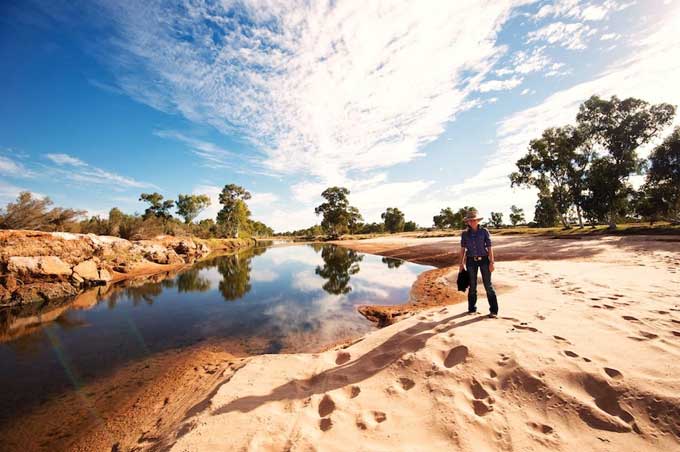 A perennial water hole on the Finke River with Alice Spencer, Program Administrator: Community, Climate and Biodiversity for R.M.Williams Agricultural Holdings. Photo by Martin Vivian Pearse, R.M.Williams Agricultural Holdings.
A perennial water hole on the Finke River with Alice Spencer, Program Administrator: Community, Climate and Biodiversity for R.M.Williams Agricultural Holdings. Photo by Martin Vivian Pearse, R.M.Williams Agricultural Holdings.
By KIERAN FINNANE
There’s more to carbon farming than locking up land and watching the grass grow. To earn money from carbon credits in this brave new world there needs to be “additionality”, in other words, the project needs to have come about as a result of the carbon markets, not as a result of land management improvements for other reasons.
There also needs to be “permanence”: the farm needs to keep doing its sequestration job (pulling carbon out of the atmosphere and storing it) in perpetuity.
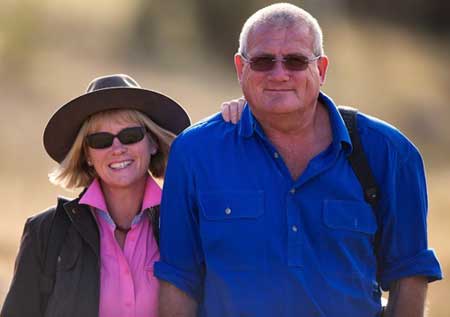 This is where there is potential for local jobs now and into the future, drawing on a similar skill set to the pastoral industry. So explained Rebecca Pearse, manager for R. M. Williams Agricultural Holdings’ carbon project on Henbury Station, when she spoke to the recent ABARES Regional Outlook* conference in Alice Springs.
This is where there is potential for local jobs now and into the future, drawing on a similar skill set to the pastoral industry. So explained Rebecca Pearse, manager for R. M. Williams Agricultural Holdings’ carbon project on Henbury Station, when she spoke to the recent ABARES Regional Outlook* conference in Alice Springs.
Ms Pearse and her husband David will be living at Henbury, 130 kms south-west of Alice, when the carbon farm “goes live” next month – quite a change from the esoteric world of the “weather derivatives market” in Europe, which is what they were involved in previously. This has given them the business experience they will need to make a go of it in the emerging carbon market.
The couple will be joined by a conservation manager, with experience in NT Parks and land management, and his wife, who’ll be involved in administrative and research support.
They are also looking to employ a full-time Indigenous graduate trainee, with qualifications in environmental science. The focus of this job will be to develop an understanding of the kind of environmental data the project needs.
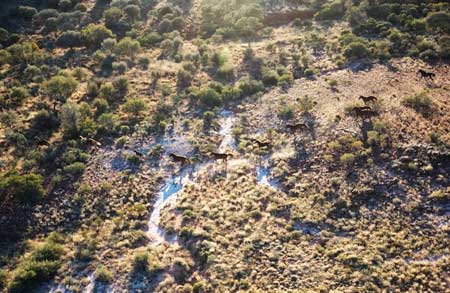 But in the immediate term and seasonally henceforth there will be jobs for locals in feral animal and plant eradication, bore maintenance, fencing and fire management, says Ms Pearse. She couldn’t say yet just how many jobs as the work plans are still being developed. And the pace of development also depends on the income-earning potential of the project, which till now, apart from Australian Government assistance ($9m) in the purchase of the property, has been paid for by R. M. Williams Agricultural Holdings.
But in the immediate term and seasonally henceforth there will be jobs for locals in feral animal and plant eradication, bore maintenance, fencing and fire management, says Ms Pearse. She couldn’t say yet just how many jobs as the work plans are still being developed. And the pace of development also depends on the income-earning potential of the project, which till now, apart from Australian Government assistance ($9m) in the purchase of the property, has been paid for by R. M. Williams Agricultural Holdings.
It is hoped to engage the residents of nearby outstations, including Southern Arrernte traditional owners, to do the work. “Indigenous co-benefit” is written into the Department of Climate Change and Energy Efficiency draft guidelines for carbon farms, says Ms Pearse, with “land sector employment” a core component.
Apart from drought, fire management to protect and promote Henbury’s 50 to 60 different vegetation communities will be the biggest challenge for the project.
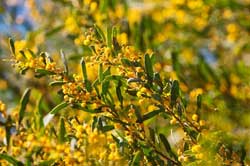 The property has already been destocked and the vegetation mapped by local scientists Peter Latz and Andrew Schubert.
The property has already been destocked and the vegetation mapped by local scientists Peter Latz and Andrew Schubert.
With the arrival of cool weather, prescribed burning has begun.
At the conference Ms Pearse was asked by pastoralist Rob Cook whether the destocking of Henbury could ever be reversed.
Right now that would be theoretically possible but soon a covenant over the land, part of the agreed process with the Australian Government, will remove the possibility.
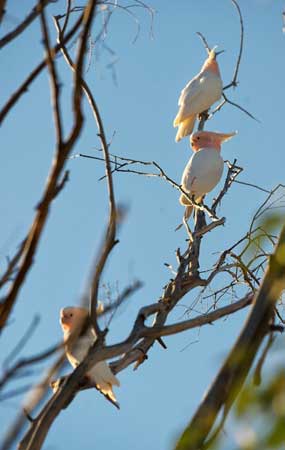 Federal Environment Minister Tony Burke told the Alice Springs News Online last September that “a key requirement of the funding deed is an in-perpetuity conservation covenant for the property. If the property were to be sold, the new owner would need to manage it for conservation under the same conservation covenant.”
Federal Environment Minister Tony Burke told the Alice Springs News Online last September that “a key requirement of the funding deed is an in-perpetuity conservation covenant for the property. If the property were to be sold, the new owner would need to manage it for conservation under the same conservation covenant.”
Ms Pearse says Henbury is in a rainfall area that makes the land very fragile and susceptible to the adverse affects of over-grazing.
Mr Cook afterwards told the News that the stations in the area have been historically among the most productive in the Centre.
“Who’s going to be growing the food we eat?” he wanted to know, saying that he feels the same regret about Henbury passing out of the cattle production sector as he would if he saw his children leave the land to take jobs in the city.
Ms Pearse says Henbury is an example of how to harness the opportunities afforded by the government’s Carbon Farming Initiative. Its focus is improved land management which will be applicable to pastoral properties without necessarily destocking.
* ABARES stands for the Australian Bureau of Agricultural and Resource Economics and Sciences. The one-day conference was one of seven around Australia, with a focus on commodity forecasts and industry trends in rural and regional communities.
Pictured, from top: Rebecca and David Pearse who will soon call Henbury Station home. •Brumbies running on Henbury. • The vulnerable Acacia Latzii or Latz’s Wattle on Henbury Station, the namesake of botanist Peter Latz who is working on the Henbury vegetation assessment. • Major Mitchell Cockatoos, Henbury Station.
Below: Minister Tony Burke with traditional owner Bruce Breaden and David Pearse, during the launch of the project in June 2011.
All photos by Martin Vivian Pearse, R.M.Williams Agricultural Holdings.
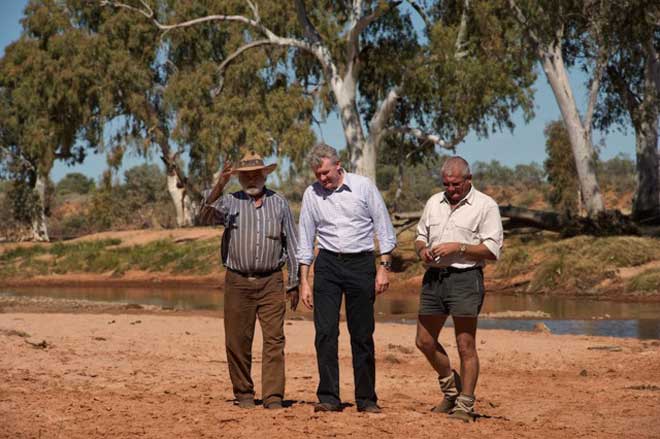



If the nine million dollar investment by the Federal Government works and Henbury pulls out the 1.4% carbon (and the oxygen atoms contained therein) that Australia contributes to global carbon levels each year, nobody else will need to do anything, we will have achieved carbon neutrality.
All we need then is to prevent carbon moving into our atmosphere from some of the big carbon polluters like Mother Nature, China, the US and we’ll have achieved a perfect environment. Maybe the trees can adapt to sucking in some other gas that we haven’t yet began to tax.
What a circus.
Great to read 🙂
May Alice Springs become our solar capital, declare itself the solar heart of our big country.
Make Alice Springs to Darwin our first solar powered electric (high speed) train line, could at least help develop towns along the way.
It is simplistic and wrong to say that locking country up will protect it from degradation. The relationship between animals and vegetation is symbiotic when managed for balance. Grazing animals need plants for food.
Plants need animals to graze them to prevent loss of ground cover and desertification which occurs when grasses die and oxidise. Plants need animals to disturb the soils around them and incorporate their carbon-rich dung and nitrogen-rich urine into it.
Grazing can reduce fuel loads, reducing the severity of wildfires. And grazing is the only way that we can produce food in the rangelands.
But not just any old grazing. Balance must be achieved by exposing the plants to grazing only to the point where the plant can easily recover. The roots of the plant need the leaves to be trimmed because they die back and then they return downwards.
In each direction – coming and going – the soil microbes are excited by the food that the roots give them. Decomposing roots are party food for bacteria, etc. Roots returning by pushing down through the soil release delicious nectars that is also party food. The more party food we can offer soil microbes, the more they will manufacture the soil carbon which builds fertility, soil stability, water efficiency, biodiversity, and resilience.
Destocking is a tactical tool, but it is not a strategy. It is not the presence of animals that is the problem; it is the recovery time allowed to the plant to deploy its leaves for maximum growth and maximum extraction of carbon from the atmosphere by the unique action of photosynthesis.
We’re becoming locked into a vicious cycle.
Our need for power to fuel a global enterprise of some 7 billion (and counting) humans is becoming – wait for it – unsustainable.
We burn hydrocarbons, and the pollution is poisoning the seas. If they warm to a certain point, the water becomes a dead zone, and there go all the fish.
We go fracking for gas, and the pollution is poisoning our fresh water aquifers.
And we remove productive land from our food supply chain, and what, please, will we be eating.
Not fish, anyway.
And not flesh from Henbury either, apparently.
Soy extracts from the quickly disappearing Amazon? Yummy!
Tiger-by-the-tail, anyone?